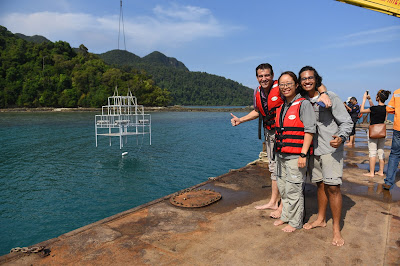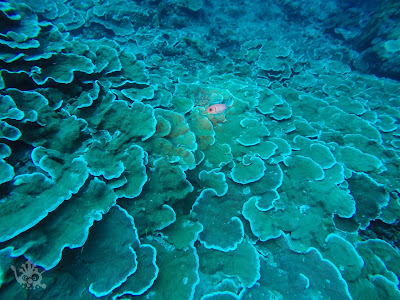To date, two videos have been uploaded - the first as an introduction to marine mammals and the latest on marine mammal tales and traditional uses in cultures across the globe. I just completed the latter lecture and it certainly brought back memories of these unique organisms as seen in the wild over the past three decades of my existence on this blue planet.
(WARNING: Much digression ahead.)
My earliest memory of marine mammals is probably from when I was about 10 years old, maybe younger, on a family trip to Pulau Langkawi. I must have seen a pod of dolphins leaping in the horizon while on a boat trip around the island as my mom captured scenic images of the beautiful sea with the jumping dolphins as black dots on the photographs using a compact film camera without a zoom. I remember my mother describing the moment to my relatives using the photographs as a visual aid, "The dolphins are the 'boogers' on the photo!"
The next time I saw marine mammals in the wild was during my first semester as an undergraduate at University of Hawaii at Hilo in the fall of 2008. I volunteered for a semi-annual Hawaiian monk seal, Neomonachus schauinslandi, count and travelled to predetermined locations on the Big Island by car to spot this endemic pinniped (semi-aquatic carnivorous marine mammals like seals, sea lions, and walruses) for an island-wide (or was it a state-wide) study on its population size and individual migratory patterns. I got in a car with the small group I was placed in led by the super inspirational and damn cool Darren Roberts (fanboy-ing now; ask me why personally) headed north to places that I have forgotten the names of (one good reason to start journalling seriously) for this count. We finally made our one and only sighting of a Hawaiian monk seal at Kauhola Point (I only remembered this location because of the lighthouse). It was sunbathing on the rocky shoreline. I was reminded to adhere to federal laws and to maintain my distance from this animal as to not harass it and also to not get my face bit off by this strong, semi-aquatic, wild animal. It was super chill though, ignoring Darren's closer examination of the identification tag(s) on its tail for the report at the end of sighting effort. After this virgin sighting of the Hawaiian monk seal, I observed it a few more times with the most memorable sighting on a summer afternoon at Richardson's Beach Park where a huge individual made its way to a freshwater/brackish pond by the car park. Good times.
 |
| The lighthouse that helped me figure out the name of location where I sighted my first ever pinniped in the wild, the endemic Hawaiian monk seal. |
 |
| A digitally zoomed image of the Hawaiian monk seal basking on dry land. |
 |
| I think I zoomed in for this photograph too. Look at the orange identification tag on its tail. I think there could be more tags on its tail, maybe even flippers, because I keep remembering seeing more than one tag. Maybe this memory is of a different individual some other time after this sighting. |
Fast forward to the year 2015, I made sightings of dolphins from the shores of Datai bay where I used to work at The Datai Langkawi, a five-star luxury resort as an informal educator. These are Indo-Pacific humpback dolphins, Sousa chinensis. I have created a reputation at my former workplace for the person that all dolphin (or any other "cool") sightings must be reported to so we can contribute to MareCet's long-term research on Langkawi dolphins. I would request my then watersports colleague to take me out on the inflatable to capture images of their fins to assist MareCet in the possible identification of individuals visiting the bay but without much luck. My colleagues, resort guests, and I would get very excited to see these animals in our bay, it was always a very special treat. The "Old Guards" of the watersports pavilion at the resort always told me that the appearance of dolphins in our bay would ALWAYS usher stormy events in the very near future. Unfortunately, I never found this to be true since the islands' weather is determined by the monsoons.
 |
| The best that I can do from shore with the animal being more than 200 m away from me, a person with no prior experience commandeering an inflatable equipped with a then five-year old 200 m zoom lens. |
2016 Earth Expeditions allowed me to see my next pinniped, the California sea lion, Zalophus californianus swimming in shallow waters. You can view a video of this sighting here. I was feeling a mix of excitement and anxiousness - excited because well, it is a cool animal that I have only previously seen in captivity and anxious because there was a huge male that swam quite close to us. I thought he was going to obliterate me!
The Sea of Cortez, or more commonly known as the Gulf of Mexico, is a deep sea due it being a rift from tectonic events off the North American Plate. Upwells in this see transport nutrient-rich waters from the cold deep sea, allowing microorganisms to thrive, creating the base of a food web capable of sustaining large organisms. While the boat carrying me and my classmates were out on "swelly" waters, I manage to catch a glimpse of a whale as the boat was travelling up the crest of the swell. It could have been either a Fin, Balaenoptera physalus, or a Bryde's whale, Balaenoptera brydei, from the size of the animal but we were not close enough to see discerning features so I cannot confirm the species. On different day out at sea, the entire class was lucky enough to observe a pod of Short-finned pilot whales (technically very large dolphins), Globicephala macrorhynchus, swimming very gently at the surface of the water. I remember being incredibly shocked and in awe of the size of the animals in this pod. There was one, I kid you not, that was the length of the boat we were on. I did not pack my DSLR on this particular Earth Expeditions, which I regret till this day (should not have packed the extra clothes), so I only have a few scenes using my GoPro Silver 4 which you can see at the beginning of this video of the non-Whale shark aquatic highlights of Sea of Cortez. (For the video on my first ever Whale shark experience, click here. The Whale shark, Rhincodon typus, is a large, filter-feeding cartilaginous fish.)
My final Earth Expeditions was to Belize in 2017. The class was out on the boat travelling in the calm coastal waters of Belize within the largest barrier reef in the western hemisphere in search of Antillean manatees, Trichechus manatus, with Belize's Manateeman, Jamal Galves, a local Belizean dedicated to the conservation of these gentle giants. When we approached an estuary at the mouth of a mangrove river, someone pointed out manatees in murky waters. This is perhaps the cutest marine mammal sighting yet for me. Even though I did not get the see the general form of the Antillean manatee due to murky waters, my classmates and I got to see the "snoots" of manatees coming up to to breathe dry air. Sirenians, the group of marine mammals like the Dugong and manatees, are related to elephants! The snout of the manatee poking out from the water for dry air reminds me of how elephants would use their trunks as snorkels when travelling in water! The snouts of sirenians are also prehensile like the trunks of elephants. My heart was leaping in excitement when I saw the manatees. Not what I expected to experience (think clear waters with tens of manatees surrounding the boat or clear waters where one can easily watch a manatee graze on seagrass from the surface), but a special experience nevertheless which I am grateful for.
 |
| The emerging snouts of a mother-calf pair (mom on the right, calf on the left). So cute! |
These animals are apex predators and/or keystone species in the ecosystems they are part of. Without them, ecosystems crumble and we risk livelihoods and the survival of humans globally, whether directly or indirectly. And of course, they have the intrinsic right of being alive as a species. Therefore, we must make change and do our part in conserving and preserving these species and their habitats. I urge you to voice out against irresponsible coastal development, demand for better/more transparent supply chain of seafood (or reduce in the consumption of aquatic species), fight against pollution of waterways, do not litter/reduce the generation of solid wastes in your household, and support responsible tourism (no speeding boats, no feeding of animals, and definitely no crowding around these charismatic animals - let them dictate your experience).


























































































